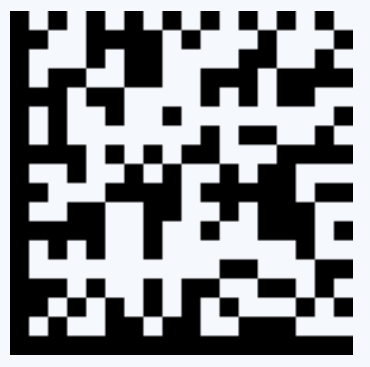What is a GS1 Data Matrix?
The GS1 Data Matrix is a highly efficient two-dimensional (2D) barcode that encodes large amounts of data in a compact matrix. Unlike traditional barcodes, they can hold extensive information such as manufacturer details, product numbers, and even expiration dates, all within a small square or rectangular symbol.

Comparison with Other 2D Barcodes
Compared to other popular 2D barcodes like QR codes, the GS1 Data Matrix is uniquely suited for industries requiring high precision and robust data integrity. This is primarily due to its enhanced error correction capabilities and its ability to be read even when printed at very small sizes or damaged.
Historical Background
The evolution of the Data Matrix into what we now know as the GS1 Data Matrix, and further into the GS1 Digital Link Data Matrix, marks a significant milestone in data encoding.
Originally developed for high-speed component labeling in the electronics and automotive industries, it has since been adopted globally across various sectors due to its reliability and comprehensive data capacity.
Specifications of GS1 Data Matrix
1. Symbol Characteristics
A GS1 Data Matrix code consists of black and white "cells" or modules arranged within a perimeter finder pattern. Key components include data regions, alignment patterns, and a quiet zone border, which is crucial for accurate scanning.
2. Encoding Data
Information within a GS1 Data Matrix is organized using application identifiers that prefix the actual data elements. The use of Function Code 1 (FNC1) in the barcode allows for the concatenation of several data fields, making it highly adaptable to different needs.
3. Error Correction and Reliability
The use of the Reed-Solomon algorithm for error correction ensures that GS1 Data Matrix codes are incredibly resilient. They can withstand physical damage up to 30% and still provide accurate data retrieval, which is indispensable in challenging environments.
Applications of GS1 Data Matrix
The GS1 Data Matrix, including the GS1 Digital Link Data Matrix, supports numerous applications across different industries. Here are detailed examples:
1. Healthcare
Tracking and managing patient records, medication, and surgical equipment. It ensures compliance with safety standards and improves patient care by reducing errors.
For instance, a major pharmaceutical company utilized GS1 Data Matrix to enhance the traceability of medicines, significantly reducing errors and improving patient safety.
2. Retail
Managing inventory and point-of-sale processes more efficiently. It provides accurate tracking of products from shipment to sale, enhancing customer satisfaction through better stock management.
3. Manufacturing
Enabling traceability of components and end-products. It is crucial for quality control, recall management, and compliance with safety regulations.
4. Logistics
Improving the accuracy of shipping and receiving data, reducing the likelihood of errors in the transport of goods, speeding up logistics operations.
How to Create a GS1 Data Matrix?
Here is a detailed step-by-step approach:
Step 1: Define the Scope of Information
Determine what information needs to be included in the barcode, based on your industry requirements or business needs.
Step 2: Choose a GS1 Data Matrix Generator
Access a free online GS1 Data Matrix generator.
Step 3: Input the Data and Create
Enter your data into the generator and create. This will include various pieces of information encoded using the appropriate Application Identifiers.
Step 4: Generate and Download
Click to generate the barcode. The GS1 Data Matrix generator will process your information and provide a downloadable image of your barcode. Print or integrate this barcode into your packaging or labeling system.
GS1 Data Matrix Guidelines and Compliance
Navigating compliance with GS1 standards is essential for businesses to ensure their barcodes meet global trade and traceability requirements. Resources for staying updated on these standards are available through various industry-specific publications and updates.
FAQs About GS1 Data Matrix
1. What is the difference between the Data Matrix and the GS1 Data Matrix?
The primary difference lies in the structure and application. A standard Data Matrix is a versatile barcode that encodes data in a compact, square format. The GS1 Data Matrix, however, is specifically formatted to adhere to GS1 standards, using Application Identifiers to ensure data consistency across global systems.
2. How long is the GS1 Data Matrix?
The GS1 Data Matrix can encode up to 2,335 alphanumeric characters. The physical size of the barcode will vary based on the amount of data encoded and the print resolution, but it is designed to remain compact to suit a wide range of applications.
3. How to decode GS1 DataMatrix?
Decoding a GS1 Data Matrix requires a scanner that is equipped to read 2D barcodes. The scanner interprets the encoded data structured by Application Identifiers and converts it into readable information. Most modern barcode scanners and mobile devices with scanning apps are capable of decoding GS1 Data Matrix codes.
To sum up, GS1 Data Matrix barcodes are indispensable tools for enhancing data accuracy and operational efficiency in numerous industries. Adopting this technology can lead to substantial improvements in business processes.
Explore our barcode generator today to start using the free GS1 Data Matrix generator and experience the benefits firsthand!




